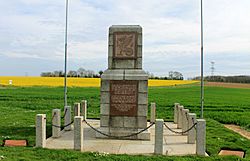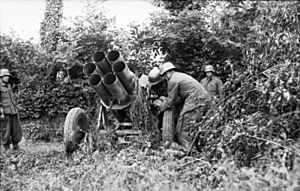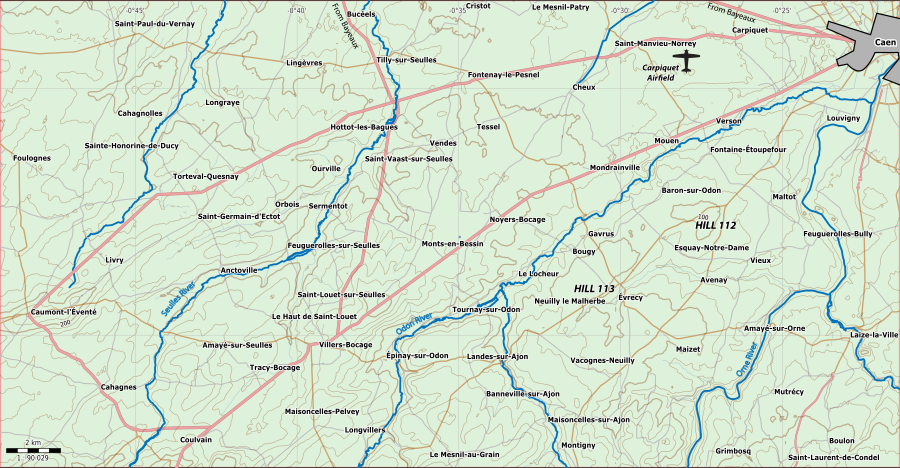Operation Jupiter (1944) facts for kids
Quick facts for kids Operation Jupiter |
|||||
|---|---|---|---|---|---|
| Part of the Battle for Caen | |||||
 Memorial to the 43rd (Wessex) Division on Hill 112. |
|||||
|
|||||
| Belligerents | |||||
| Commanders and leaders | |||||
| Units involved | |||||
|
|
||||
| Casualties and losses | |||||
| c. 2,000 casualties (43rd Division only) 58 tanks |
|||||
Operation Jupiter was a military attack by the British Army during the Second World War. It happened from 10 to 11 July 1944, as part of the bigger Battle of Normandy. The main goal for the British 43rd (Wessex) Infantry Division was to capture some villages like Baron-sur-Odon and Fontaine-Étoupefour, and to take back a very important place called Hill 112.
Another group, the 15th (Scottish) Infantry Division, was supposed to capture Éterville and Maltot. After these areas were taken, tanks from the 4th Armoured Brigade would move through and secure more villages. The British hoped to achieve their first goals quickly, but the fighting for Hill 112 lasted all day.
On 11 July, German forces launched strong counter-attacks. They pushed the British off the very top of Hill 112. Even though the British didn't fully achieve their goals for this specific operation, it was still a success for the Allies in the long run. The intense fighting weakened the German forces a lot. Later, on 4 August, the British finally took Hill 112 easily, as the Germans had moved away. A stone memorial was built on the hill to remember the soldiers of the 43rd (Wessex) Infantry Division.
Why This Battle Happened
First Fight for Hill 112
The first time Hill 112 was fought over was during Operation Epsom. This was an earlier battle where British tanks tried to break through German lines. Hill 112 was a key spot on the way to the River Orne. The British managed to capture the hill but had a hard time holding it.
The Germans quickly sent in more tanks and soldiers. The British leader, General Bernard Montgomery, decided to pull his troops back from the hilltop. He wanted to keep the German tank divisions busy on the British-Canadian front. This would allow the American army to push forward and break out from their beachhead further west.
Taking Caen: Operation Charnwood
Operation Charnwood happened just before Operation Jupiter, from 8 to 9 July. Its goal was to capture the city of Caen and stop German tanks from moving to fight the Americans. British and Canadian infantry divisions, supported by tanks, slowly pushed forward against strong German resistance.
By the end of the operation, the Allies had reached Caen and secured the north side of the Orne River. This was a costly battle for both sides, but it was a success for the Allies. The Germans were pushed out of northern Caen, but they set up new defenses south of the city.
Planning the Attack
British Battle Plan
The main idea behind Operation Jupiter was to capture bridges over the Orne River. This would create a way for the British army to attack towards other important towns like Falaise. The 43rd (Wessex) Infantry Division was tasked with capturing the high ground around Hill 112.
The plan involved different groups of soldiers. The 129th Infantry Brigade would take the top of Hill 112, while the 130th Infantry Brigade would secure the lower areas. They would have support from Churchill tanks and special flame-throwing tanks called Churchill Crocodiles. Another group, the 46th (Highland) Infantry Brigade, would help secure the flanks.
Artillery Support
The British planned to use a huge amount of firepower. Many artillery units from different divisions would fire their guns. This included hundreds of field guns and medium guns. Even large naval ships like HMS Rodney and HMS Belfast in the Bay of the Seine would use their powerful guns to support the attack.
In total, over 500 artillery pieces and naval guns were ready to fire. Heavy mortars would also be used, and Hawker Typhoon fighter-bomber planes would attack German positions.
German Defenses
Hill 112 was strongly defended by the German 10th SS Panzer Division Frundsberg. They had infantry soldiers dug in on the hill and tanks hidden in wooded areas. Their defenses included several lines of outposts and main resistance lines.
The Germans also had powerful Tiger tanks from the 102nd SS Heavy Panzer Battalion. They had artillery support and could observe the British movements from positions across the Orne River.
The Battle Unfolds
Operation Jupiter started with a heavy bombardment. The first British battalions reached Éterville and the north side of Hill 112 early in the morning. They began to advance towards Maltot. British soldiers entered Maltot, but the German defenders fought back hard. They used mortar fire and tank counter-attacks, making it difficult for the British to hold the village without control of Hill 112.
The Germans stopped the British advance on Hill 112 at the Caen–Évrecy road. In the evening, the 5th Battalion, Duke of Cornwall's Light Infantry (5th DCLI), supported by tanks, attacked the hill again. They managed to reach the hilltop and nearby woods.
German counter-attacks began around midnight. They tried to retake Éterville several times. On Hill 112, the 5th DCLI was forced back after losing all their anti-tank guns and suffering many casualties. The German commander, General Heinrich Eberbach, made defending Hill 112 his top priority. Even with heavy naval, air, and artillery attacks, the Germans held much of their ground, especially with the help of their Tiger tanks.
After the Battle
Soldier Losses
The 43rd (Wessex) Division lost about 2,000 soldiers during Operation Jupiter. The 31st Tank Brigade lost 39 tanks. The German 9th SS Panzer Division and 10th SS Panzer Division also suffered many casualties and lost a lot of their tanks. The 102nd SS Heavy Panzer Battalion, which had 25 Tiger tanks at the start, had only 10 left a few days later.
Remembering the Battle
The importance of the battles for Hill 112 is remembered with several memorials. The 5th DCLI built a memorial called Cornwall Wood in August 1944. A larger wooden memorial was built by local people to honor both soldiers and civilians who died. A stone memorial was also built on Hill 112 by the 43rd (Wessex) Infantry Division in the late 1940s.
Later Operations
Fighting Continues: 11 July
On the evening of 11 July, the 4th Battalion, Somerset Light Infantry (SLI), tried a quiet attack on the top of Hill 112. They faced heavy machine-gun fire and were pushed back. The top of Hill 112 was constantly hit by artillery, mortar, and machine-gun fire, making it very dangerous for both sides.
Operation Greenline: 15–17 July
Another attack, Operation Greenline, aimed to capture crossroads and higher ground near Esquay-Notre-Dame. British soldiers, supported by Churchill tanks and flame-throwing tanks, advanced through heavy German fire. They managed to capture some key positions, but the fighting was very tough. German counter-attacks were strong, but British artillery helped push them back.
Operation Express: 22 July
Operation Express started from the village of Louvigny. The British 5th Battalion, Wiltshire Regiment (5th Wilts), and tanks attacked the village and nearby areas. The Germans were surprised at first, but then fierce hand-to-hand fighting broke out. German Tiger tanks counter-attacked, but British fighter-bombers forced them back.
The British continued to fight through woods and farms. They eventually captured most of their objectives, including a strongly defended farm. The fighting for Maltot was intense, lasting into the night. By the end of the operation, the British had taken over 400 German prisoners. This battle was considered a "text-book" operation because the commanders had planned it very carefully.
The 43rd (Wessex) Division was then replaced by the 53rd (Welsh) Division. The Germans finally pulled back from Hill 112 in August, as other major operations were happening further west. The 53rd (Welsh) Division then occupied the hill with almost no fighting on 4 August.




